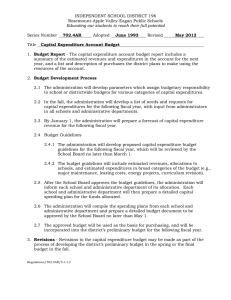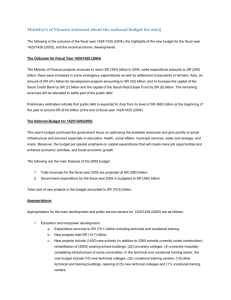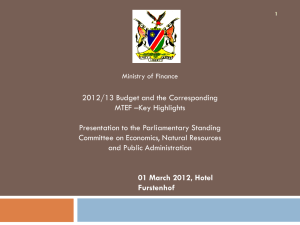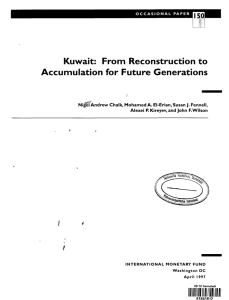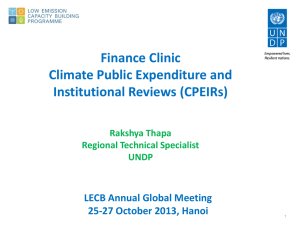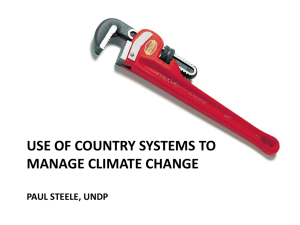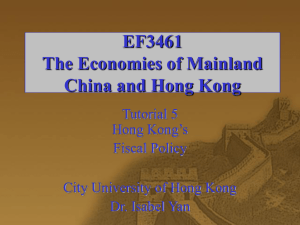ANNEX 7
advertisement
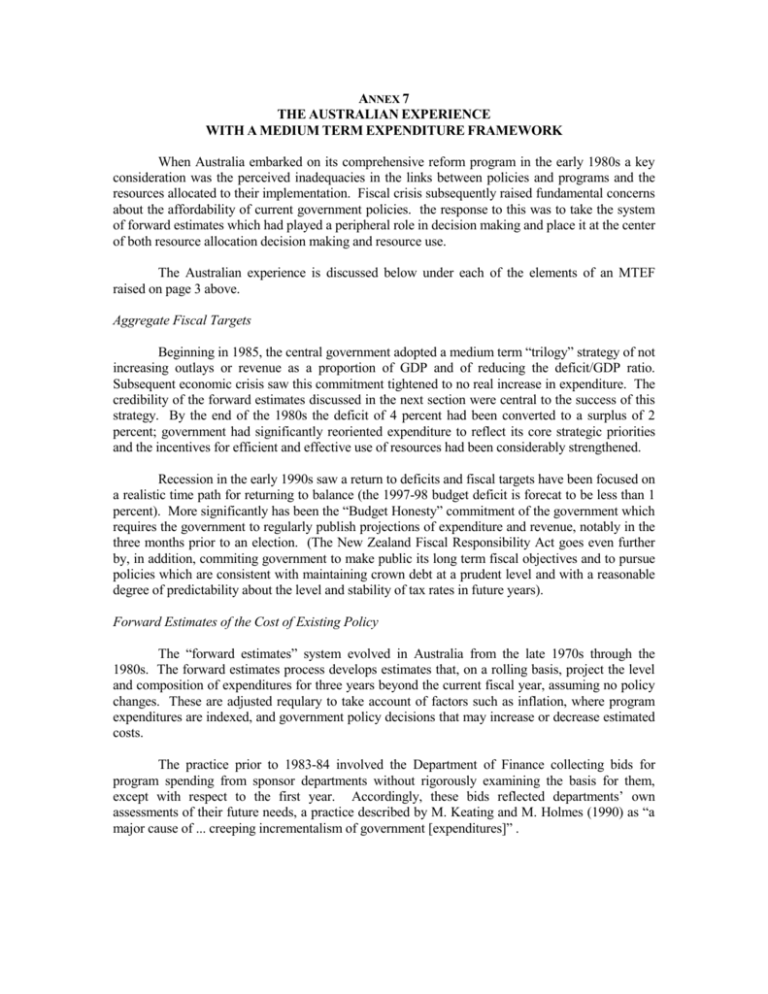
ANNEX 7 THE AUSTRALIAN EXPERIENCE WITH A MEDIUM TERM EXPENDITURE FRAMEWORK When Australia embarked on its comprehensive reform program in the early 1980s a key consideration was the perceived inadequacies in the links between policies and programs and the resources allocated to their implementation. Fiscal crisis subsequently raised fundamental concerns about the affordability of current government policies. the response to this was to take the system of forward estimates which had played a peripheral role in decision making and place it at the center of both resource allocation decision making and resource use. The Australian experience is discussed below under each of the elements of an MTEF raised on page 3 above. Aggregate Fiscal Targets Beginning in 1985, the central government adopted a medium term “trilogy” strategy of not increasing outlays or revenue as a proportion of GDP and of reducing the deficit/GDP ratio. Subsequent economic crisis saw this commitment tightened to no real increase in expenditure. The credibility of the forward estimates discussed in the next section were central to the success of this strategy. By the end of the 1980s the deficit of 4 percent had been converted to a surplus of 2 percent; government had significantly reoriented expenditure to reflect its core strategic priorities and the incentives for efficient and effective use of resources had been considerably strengthened. Recession in the early 1990s saw a return to deficits and fiscal targets have been focused on a realistic time path for returning to balance (the 1997-98 budget deficit is forecat to be less than 1 percent). More significantly has been the “Budget Honesty” commitment of the government which requires the government to regularly publish projections of expenditure and revenue, notably in the three months prior to an election. (The New Zealand Fiscal Responsibility Act goes even further by, in addition, commiting government to make public its long term fiscal objectives and to pursue policies which are consistent with maintaining crown debt at a prudent level and with a reasonable degree of predictability about the level and stability of tax rates in future years). Forward Estimates of the Cost of Existing Policy The “forward estimates” system evolved in Australia from the late 1970s through the 1980s. The forward estimates process develops estimates that, on a rolling basis, project the level and composition of expenditures for three years beyond the current fiscal year, assuming no policy changes. These are adjusted requlary to take account of factors such as inflation, where program expenditures are indexed, and government policy decisions that may increase or decrease estimated costs. The practice prior to 1983-84 involved the Department of Finance collecting bids for program spending from sponsor departments without rigorously examining the basis for them, except with respect to the first year. Accordingly, these bids reflected departments’ own assessments of their future needs, a practice described by M. Keating and M. Holmes (1990) as “a major cause of ... creeping incrementalism of government [expenditures]” . Under the new approach, the Department of Finance negotiated with departments the estimates for existing programs, and then assumed responsibility for updating the forward estimates at regular intervals to reflect, as indicated above, changes in economic parameters, other technical variations and, most important, the effects of government policy decisions. The same process is followed with new policy and program proposals, for which projected costs for the full forward estimates period are required as part of the policy proposal considered by Cabinet. Thus, the Department of Finance is seen as “owning” the forward estimates. Furthermore, whereas previously there tended to be widespread annual renegotiation of estimated expenditures, the new system is much more policy focussed, involving ministers primarily in the relatively small percentage of budgetary matters that require policy or strategic decisions (although the funding implications may involver a high proportion of budget funding). Thus, the forward estimates are a disciplining mechansim in the budgeting process that enables a greater focus on strategic policy issues. At the same time, they provide much greater predictability as to resource levels for departments and agencies. In essence, the system envisages that if government policy does not change then funding will be provided in accordance with the forward estimates. One senior offical has attested to the significant impact of forward estimates as follows: The fact that we now have a budget system in place with forward estimates, and the haggle over the base for each new budget year does not take place any more, is a huge advance. If you had to pick out the one thing that we have done above all others, this reform would be the most dramatic change. In 1983, a significant decision in the evolution of the forward estimates system was made when the government decided to publish them. The requirement to disclose costs for the three-year forward period was intended to ensure that decisions were made with greater awareness of future commitments, and to provide Parliament and the public with better information about budgetary realities and public expenditure patterns and priorities. The decision to publish also meant that forward estimates had to be taken more seriously, thus leading to their progressive upgrading (M. Keating, M. Holmes 1990). As the system has evolved, the government is required to disclose and justify the costs of policy decisions leading to discretionary changes in expenditures over the three-year forward estimate period. The estimates are published in the budget alongside the budget year figures and changes between the forward years and the budget are reconciled in budget documents -- that is, the budget estimates are reconciled with the forward estimates compiled the previous year. These reforms have tended to shift the focus for ministers and senior officials to a medium-term period (of four years), rather than the current budget year. The impact of the forward estimates has been such that an evaluation of government reforms in 1993, in linking the forward estimates system to the record of overall government spending restraint, characterized them as”central to the expenditure control process”. More recntly, a former official who had been instrumental in the development of the government’s budgetary and financial management reforms of 1980s stated: The forward estimates process and system was so central because it provided the backbone which linked the Expenditure Review Committee’s (see below) macroeconomic and strategic policy-making, portfolio budgeting, and the running costs system [the latter is discussed in a separate note]. It has provided a framework for a more strategic approach to decision making, much greater predictability in funding for current policies and for removing from the budgetary arena those decisions best made elsewhere (most notably management decisions). The system has built on trust and has changed behaviour fundamentally. Perhaps the most important factor here has been the fact that, having changed the formal rules, all the players have played by the new rules (1996 interview). Institutional Mechanisms for Making the Trade-offs There can be little doubt that the Expenditure Review Committee (ERC) established by the Labor Government in the mid-1980s was central to the subsequent improvements in all three levels of budgetary outcomes. This committee was a sub-committee of the Cabinet, consisting not only of the Prime Minister, the Treasurer and Minister of Finance but also of a number of other senior “spending” ministers. This committee was responsible for determining the overall fiscal framework and for managing strategic policy making, including policy changes necessary to reflect fiscal realities as well as the shifting priorities of the government. One of the key strategic decisions made by the ERC was the resource envelope for each sectoral minister for finalization of the annual budget. Depending on whether the envelope was higher or lower than the forward estimates of existing policy (adjusted for the individual policy decisions made by ERC - see previous paragraph), individual sector ministers would have to seek programmatic changes that would produce savings or they may be able to introduce new initiatives. The key point here is that it was left to sector ministers to determine the best allocation of resources to policies and programs in their sector consistent with overall government policy and within a hard budget constraint. The third element of the system was the running costs system. This system, which is discussed in some detail in a separate annex, provides line managers with considerable flexibility in managing their personnel and administrative resources within a hard budget constraint but one which is predictable over the medium term. This system has eliminated the annual haggle over funding levels for administration and has meant that ministers have been freed from involvement in decsions at this level. It is the efficiency dividend component of the system which has enabled decisions on running costs to be kept out of the Cabinet arena and has built the trust between line agencies and the Ministry of Finance. Finally, it is worth noting that the forward estimates system has enabled the Ministry of Finance to assume something of a banker role. This can be illustrated by reference to the example of the major modernization of the Australian tax system. This involves an investment of over A$1billion. Because of the forward estimates, MOF was able to reduce the Tax Office’s running costs in the outyears for the savings generated by the investment. The benefits from this are obvious, not least in the changed incentives on line agencies to have sound analysis of expenditure proposals.
